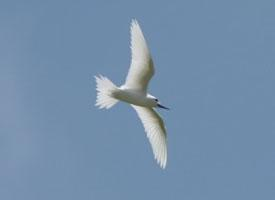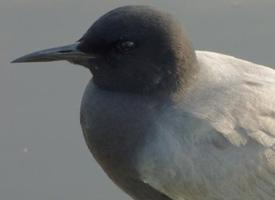
Description de l'animal
The White Tern, scientifically known as Gygis alba, is a small seabird renowned for its ethereal beauty and distinctive nesting behavior. With its graceful flight and pure white plumage that gleams under the tropical sun, this bird is a mesmerizing sight in the regions it calls home. The White Tern is also known by other names such as the Fairy Tern, Angel Tern, or even the White Noddy in certain locales, each name reflecting a characteristic that makes this bird seem like a creature out of a fairy tale.Adult White Terns are predominantly white all over, with a slight bluish or greyish tinge on their back and wings, which is often only noticeable up close or in certain lighting conditions. They have long, narrow wings and a short, forked tail which, combined with their light body weight, allows them to maneuver with remarkable agility in the air. Their beak is pointed and black, contrasting with their dark eyes, which are surrounded by a thin, black ring, giving them a striking appearance.
One of the most fascinating aspects of the White Tern is its breeding behavior. Unlike most seabirds, White Terns do not construct traditional nests. Instead, they lay their single egg directly onto a bare branch in a tree or on a cliff ledge. This peculiar nesting choice is a marvel of nature, as the egg manages to stay in place despite the wind and the coming and going of the parents. The chick that hatches is well adapted to its precarious birthplace, with strong feet to hold on to its perch from day one.
White Terns are found across the tropical and subtropical oceans of the world, including the Pacific, Atlantic, and Indian Oceans. They are particularly associated with coral islands and atolls, where they can be seen flying over the open sea, foraging for fish and squid. Their flight is buoyant and effortless, often hovering over the water's surface before plunging in to catch their prey.
Their call is a gentle, high-pitched "keer" or "kirr," adding to their ethereal presence as they glide above the ocean waves. During the breeding season, their vocalizations become more varied, including soft cooing sounds that contribute to their angelic image.
Despite facing threats from habitat loss and introduced predators on some islands, White Tern populations remain relatively stable across much of their range. They are a testament to the adaptability and resilience of seabirds, continuing to thrive in their oceanic realms.
In many cultures, the sighting of a White Tern is considered a good omen, symbolizing peace, purity, and the presence of guardian spirits. Their beauty and unique characteristics have not only made them a subject of fascination among birdwatchers and nature enthusiasts but have also earned them a special place in the folklore and traditions of the island communities with which they share their habitat.
In conclusion, the White Tern, with its stunning white plumage, remarkable nesting habits, and graceful flight, is a captivating presence in the tropical seas. Its existence is a reminder of the wonders of the natural world and the importance of conserving the delicate ecosystems that sustain such extraordinary species.
Animaux similaires
Nouvelles photos d'animaux
Top 10 des animaux
- Dolphin gull (Leucophaeus scoresbii)
- Diana monkey (Cercopithecus diana)
- Moustached guenon (Cercopithecus cephus)
- Galápagos tortoise (Geochelone nigra complex)
- Stone loach (Barbatula barbatula)
- Japanese macaque (Macaca fuscata)
- Russian tortoise (Testudo horsfieldii)
- Greek tortoise (Testudo graeca)
- Common flying dragon (Draco volans)
- Vendace (Coregonus albula)


